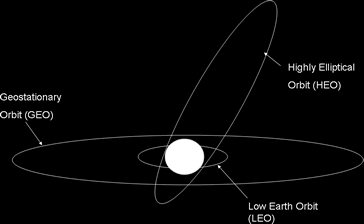
Why Do Satellites Stay In Space?
As you may know, all objects are pulled towards the Earth by a force called "gravity." So why doesn't a satellite simply fall back to Earth after it is put into space?
Perhaps the best way to explain why satellites stay in space is through a demonstration. Watch this demonstration, in which two students from Thomas Jefferson High School in Alexandria, Virginia, demonstrate the forces that affect satellites in space and explain why satellites stay in orbit around the Earth.
As demonstrated in the video, two factors determine the orbit of an object. The first factor is the gravity of the Earth, which exerts an attraction towards the center of the Earth. This is called "centripetal force." The second factor is the speed, or "velocity," at which the satellite is moving. The force provided by the velocity of the object is called "centrifugal force." If one force is greater than the other, then the satellite will either fall back to Earth or spin off into outer space. If the forces are balanced, then the satellite remains in a stable orbit around the Earth.
Let's examine at some of the types of orbits typically used by satellites to provide communications.

In the end, all human-made satellites will fall back to Earth, since objects eventually lose velocity and are overcome by the Earth’s gravity. It may take a very long time for this to happen, however, because satellites are so high in space. Satellites near the Earth in low-Earth orbit may take 10, 20, or 100 years to fall back to Earth. Satellites higher up in highly-elliptical or geostationary orbits may take hundreds, thousands, or even million of years to fall back to Earth. Objects falling back to Earth will burn up in the atmosphere due to the friction caused by the Earth’s atmosphere.
|
இதற்கு குழுசேர்:
கருத்துரைகளை இடு (Atom)

கருத்துரையிடுக Facebook Disqus